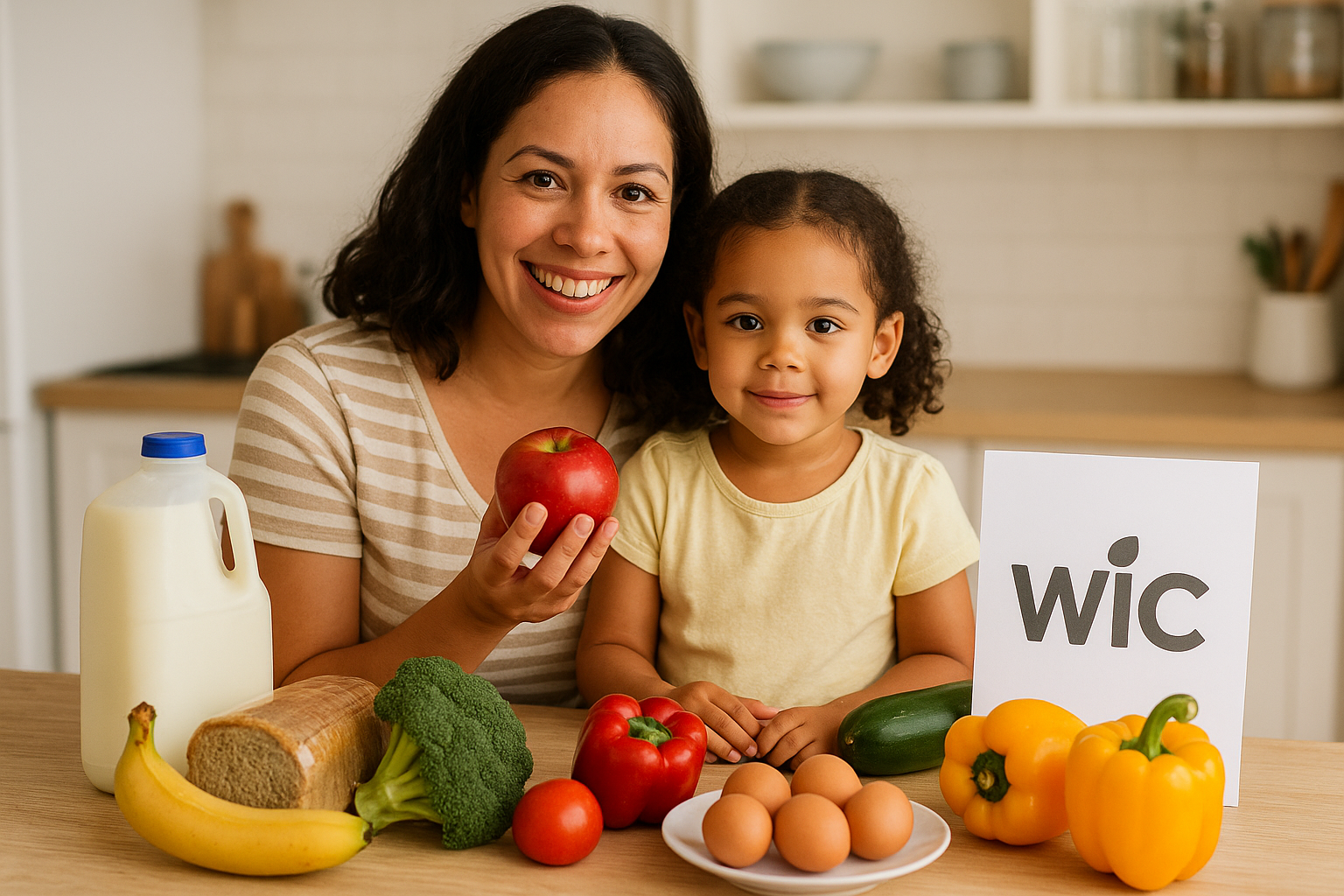Food Assistance with the WIC Program: Millions of families use the Special Supplemental Nutrition Program for Women, Infants, and Children (WIC) to get nutritious food, breastfeeding support, and referrals to health and social services. If you’re pregnant, breastfeeding, recently postpartum, or caring for a child under 5, WIC may help stretch your grocery budget and connect you to local resources — fast. This friendly, step-by-step guide shows you how to check eligibility, gather documents, apply, shop with the eWIC card, and make the most of WIC services in 2025.
Why WIC matters right now
WIC is a federally funded program administered through state, local, and tribal agencies that provides targeted nutrition support to those who need it most: pregnant and postpartum people, breastfeeding mothers, infants, and children under 5. WIC combines monthly food benefits, nutrition education, breastfeeding support, and referrals — built to improve maternal and child health. The program’s rules and food packages were updated recently to reflect current nutrition science, so now is a good time to check whether you (or someone you care for) qualify. (USAGov, Food and Nutrition Service)
Quick preview — what you’ll learn (so you can act right away)
- Who qualifies for WIC and the income rules you need to know. (Food and Nutrition Service)
- Exactly what WIC gives you (foods, EBT card, counseling, breastfeeding help). (Food and Nutrition Service)
- How to apply (where to call, what to bring, and how to find a local clinic). (Food and Nutrition Service)
- Shopping tips for the eWIC card and using your benefits smartly. (Food and Nutrition Service)
- A printable checklist and FAQs so you won’t miss a step.
1 — Am I eligible? The short answer and the numbers
WIC serves four main categories:
- Pregnant people (through pregnancy)
- Breastfeeding people (up to their baby’s first birthday)
- Postpartum people (a limited time after pregnancy)
- Infants and children up to their 5th birthday
WIC is income-based (but many people are income-eligible if they already receive SNAP, Medicaid, or TANF). The program sets income limits at up to 185% of the federal poverty guidelines (states may set thresholds within required ranges). The federal WIC income guidelines are updated annually and the 2025–2026 table is published by USDA/FNS. If you’re unsure whether your household qualifies based on income, your local WIC clinic will check it for you during the intake. (Food and Nutrition Service)

2 — Proof that counts: documents to gather before you call
To speed up your appointment, have these documents ready (digital photos or paper copies both work in most clinics):
- Photo ID for the parent/guardian (driver’s license, state ID, passport)
- Proof of pregnancy (if pregnant) — a note from a provider or clinic record usually works
- Child’s birth certificate or hospital paperwork (for infants/children)
- Proof of income for everyone in the household (pay stubs, letter from employer, recent tax return, or proof of public benefits like SNAP/Medicaid)
- Proof of residency (a utility bill, lease, or official mail with your address)
- Social Security numbers, if you have them (NOT required to apply but helpful)
If you already receive SNAP, TANF, or Medicaid, many states will treat you as income-eligible automatically — tell this to the WIC staff. Local clinics will give you a complete list by phone or on their website. (Food and Nutrition Service)
3 — How to apply: three easy paths
- Call or visit your local WIC clinic to schedule an appointment (this is the most common method). Use the USDA WIC program contacts map to find the right agency. (Food and Nutrition Service)
- Apply online (some states) — many state WIC programs offer online screening and appointment requests; check your state WIC website. (Examples: state WIC portals provide clinic locators and online pre-screeners.) (Coloradowic, Women, Infants, and Children)
- Walk in (where available) — some clinics accept walk-ins, but many ask you to schedule to reduce wait times and allow virtual visits.
At your appointment WIC staff will: confirm eligibility, measure and weigh the child (if applicable) to assess nutrition risk, enroll you, issue benefits (often an eWIC card), and schedule follow-ups or nutrition counseling. (Food and Nutrition Service)
4 — What WIC gives you (monthly benefits + services)
WIC provides a tailored package of benefits based on life stage and nutritional need. Typical elements include:
- Monthly food benefits you buy with an eWIC card (items vary by age and state but commonly include formula/infant foods, iron-fortified cereal, milk or milk alternatives, eggs, cheese, yogurt, whole grains, peanut butter, fruit/vegetable cash value vouchers, and canned fish for breastfeeding moms). State WIC food lists vary within USDA standards. (Food and Nutrition Service)
- Electronic Benefit Transfer (eWIC) card that works like a debit card dedicated to WIC food items — simpler and more discreet than old paper vouchers. Many states now offer eWIC and allow virtual appointments for some services. (Food and Nutrition Service)
- Nutrition education: personalized counseling on infant feeding, meal planning, and healthy choices. (Food and Nutrition Service)
- Breastfeeding support: lactation consultation, peer counselors, extra food benefits for breastfeeding moms, and a breastfeeding help network. WIC places high priority on breastfeeding support and has national resources to help participants. (WIC Breastfeeding Support, Food and Nutrition Service)
- Referrals to other services: immunizations, Medicaid, SNAP, or local health clinics.
Note: USDA revised WIC food packages in 2024 to include more whole grains, fruits & vegetables, culturally diverse choices, and more plant-based milk options in some cases — states are implementing updates in phases. Check your state’s WIC food list for the exact items you can buy. (Food and Nutrition Service, Reuters)
5 — Using your eWIC card at the store — a quick how-to
- Activate & sign: your clinic will give you an eWIC card and instructions. Some states mail cards; others issue them at the clinic.
- Know your balance and allowed items: most states provide balance checks via phone, app, or printed receipts. WIC-eligible items show on a state WIC food list — the cashier’s cash register should recognize WIC items if the store accepts eWIC. (Food and Nutrition Service)
- Keep receipts: receipts show what you purchased with WIC benefits — keep them for your records and to track remaining benefit balances.
- Use the monthly allowance: WIC benefits refresh monthly; plan purchases so you don’t miss items you need.
If a store’s register won’t accept an item you believe is WIC-eligible, call your WIC clinic — sometimes state lists and local retailer inventories are out of sync and can be updated. Many WIC state agencies maintain an up-to-date list of authorized WIC vendors. (Food and Nutrition Service)
6 — Breastfeeding support: what to expect and how to get more help
Breastfeeding services are a core WIC benefit. If you’re breastfeeding, WIC can provide:
- Extra food packages for breastfeeding moms (compared with formula feeding), peer counselor programs, lactation consultant visits, and breastfeeding hotlines in many states. WIC promotes breast-friendly workplaces and community support. (WIC Breastfeeding Support, Food and Nutrition Service)
If you want to breastfeed, tell staff during enrollment so they can connect you with peer counselors and local lactation resources. If you’re having trouble, WIC can often accelerate help — including in-person clinic visits or phone support.
7 — Formula availability & special nutrition needs
WIC covers infant formula for babies who need it. If your infant requires a special formula for medical reasons, WIC can provide it when documented by a health care provider. Always discuss special feeding needs at your WIC appointment so staff can authorize the correct products. WIC agencies also adjusted food packages in 2024 to better reflect cultural diets and allergy-friendly choices; check local lists for allowable substitutions. (Food and Nutrition Service, Reuters)

8 — Recertification, reporting changes & staying enrolled
- Recertify on schedule: WIC participants must re-verify eligibility periodically (typically every 6 or 12 months depending on age and program rules) — your clinic will tell you when. Many states allow some recertification steps to be done virtually. (Food and Nutrition Service)
- Report major changes: if your income, address, or household composition changes, notify your WIC clinic — it may affect eligibility or benefit amounts.
- Lost card? Report a lost/stolen eWIC card immediately to your WIC clinic or your state’s eWIC contact to protect your benefits. State WIC pages have instructions for replacing cards. (Food and Nutrition Service)
9 — If you don’t qualify for WIC: other food help
If you don’t meet WIC criteria, other programs may help:
- SNAP (food stamps): broader eligibility, monthly food benefits for low-income households. Apply through your state SNAP office or HealthCare.gov where applicable. (Food and Nutrition Service)
- Temporary or emergency food assistance: call 211 to find local food pantries and emergency meal programs. USA.gov provides a guide to emergency food help. (USAGov)
10 — Real-life tips: make WIC work better for your family
- Bring your grocery list and a screenshot/photo of the state WIC food list when you first shop — it helps the cashier and speeds checkout.
- Ask your clinic for recipes and meal ideas that use WIC items — nutrition education is part of the program.
- If you’re working or have limited clinic hours, ask about virtual appointments and phone check-ins — many clinics offer them to save time. (Food and Nutrition Service, Coloradowic)
- Keep your eWIC PIN private — treat it like a debit card PIN.
- If a retailer won’t accept WIC foods correctly, call your WIC clinic. If problems persist, you can escalate through your state WIC agency.
Final Checklist: Apply & Use WIC (copy this)
- Confirm eligibility (pregnant, breastfeeding, postpartum, infant/child under 5). (Food and Nutrition Service)
- Gather documents: ID, proof of income, proof of residency, child’s birth info. (Food and Nutrition Service)
- Find your local clinic and schedule an appointment (or start an online pre-screen if your state offers it). (Food and Nutrition Service)
- Attend your WIC appointment and enroll — get your eWIC card and orientation. (Food and Nutrition Service)
- Learn the WIC food list and shopping rules in your state; plan purchases each month. (Food and Nutrition Service)
- Ask about breastfeeding support and nutrition classes — they’re free with WIC. (WIC Breastfeeding Support)
- Keep documentation and report changes or recertify on time. (Food and Nutrition Service)
Official links — verified and clickable (use these to apply or confirm details)
- Get started and compare programs (USA.gov food assistance): https://www.usa.gov/food-assistance. (USAGov)
- USDA FNS — WIC program overview and benefits: https://www.fns.usda.gov/wic. (Food and Nutrition Service)
- How to apply for WIC (step-by-step): https://www.fns.usda.gov/wic/applicant-participant/apply. (Food and Nutrition Service)
- WIC income eligibility guidelines (2025–2026 table): https://www.fns.usda.gov/wic/income-eligibility-guidelines-2025-26. (Food and Nutrition Service)
- WIC food packages and what’s allowed: https://www.fns.usda.gov/wic/food-packages. (Food and Nutrition Service)
- WIC EBT (eWIC) and card info: https://www.fns.usda.gov/wic/ebt. (Food and Nutrition Service)
- WIC program contacts and local clinic finder (USDA map): https://www.fns.usda.gov/wic/program-contacts. (Food and Nutrition Service)
If you want, tell me your ZIP code and I’ll fetch the phone number and clinic link for your nearest WIC office (I can only use the state/local contact pages above to find the clinic).
Frequently Asked Questions (brief)
Q: Will WIC affect my immigration status or public charge?
A: WIC is a nutrition program and does not count as a public charge. Non-citizens should check eligibility details with the clinic — WIC rules about documentation and participation vary by circumstance; your clinic can explain. (Confirm with your local WIC agency.) (Food and Nutrition Service)
Q: Can I be enrolled in both SNAP and WIC?
A: Yes — many families receive both SNAP and WIC. SNAP eligibility often makes you automatically income-eligible for WIC in many states. (Food and Nutrition Service)
Q: Are WIC benefits taxable?
A: No — WIC benefits are not taxable income. They are a targeted nutrition benefit. Confirm with your clinic or a tax advisor if you have unusual questions.
Closing — act now and get help today
WIC is intentionally low-barrier: call your nearest WIC clinic, ask the simple screening questions, and bring the basic documents listed above. Even if you’re uncertain about eligibility, a short call to a clinic can save you money on groceries and get your child nutrition support sooner. Use the USA.gov food assistance page above for an overview and the USDA links for the official program details and state clinic contacts. (USAGov, Food and Nutrition Service)
Disclaimer: This guide is informational only and does not constitute legal, medical, or immigration advice. Program rules and income thresholds are updated periodically; verify eligibility and benefits with your local WIC clinic or the official USDA and USA.gov pages linked above. All official links were checked and valid as of August 2025. (Food and Nutrition Service). All images used in this article are royalty‑free or licensed for commercial use and are provided here for illustrative purposes.
